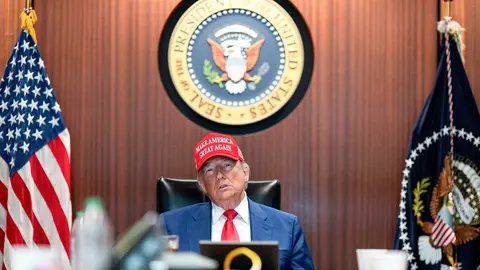Trump humiliates the EU with his tariffs and pushes it to the brink of recession

Various political groups in different EU countries are so outraged that they are even calling for the head of Ursula von der Leyen, President of the European Commission.
In the aforementioned tariff letters, Trump threatened the EU with a reciprocal tariff of 30% that would come into effect on 1 August, forcing the EU into rushed negotiations under the threat of raising the tariff to 50%. The Europeans arrived practically defeated and resigned to reaching the least bad agreement with Washington.
In other words, Trump's will has been completely imposed: reciprocal tariffs were finally set at 15% and not 10% as proposed by the European Commission; nor has Trump lifted a finger to reduce the 50% tariffs on steel, copper and aluminium in the face of growing concern from European steelmakers, who are already expecting losses or a considerable reduction in sales.
The Turnberry agreement (signed at the Trump Turnberry golf club in Scotland) also contains small print, as was the case a few days ago with the US tariff negotiations with Japan.
For the EU, the demand has been categorical: according to the report provided by the White House, the EU will purchase $750 billion in US energy and make new investments of $600 billion in the US by 2028 at the latest. And, in the area of armaments, the European Union agreed to purchase significant amounts of US military equipment.
‘This colossal agreement will enable American farmers, ranchers, fishermen and manufacturers to increase US exports, expand trade opportunities and help reduce the trade deficit in goods with the European Union,’ according to the White House.
How big is the US deficit with Europe? Based on information provided by the European Commission, it is important to differentiate between the balance of services and the trade balance. In the former, last year, the European Union imported services from the United States worth 482.5 billion euros, while it sold services to the United States worth 334.5 billion euros. In other words, in the balance of services, the United States has a surplus of 148 billion euros.
The EU sells professional, scientific and technical services to the United States; in return, it buys professional, scientific and technical services, telecommunications, IT and information services, and also pays fees for the use of intellectual property.
The trade balance is the opposite. In this section, last year, trade in goods between the EU and the United States amounted to 867 billion euros, a buoyant trade that has doubled in the last decade; in 2024, the EU sold goods to the United States worth 532.3 billion euros and, in contrast, purchased a total of 334.8 billion euros from the United States. In other words, there is a deficit of 197.5 billion euros that Trump wants to correct at all costs.
On more than one occasion, the US president has branded Europeans as ungrateful and accused them of taking advantage of Americans, claiming that they treat them very badly.
What do they sell most to the United States? Above all, medicinal and pharmaceutical products; vehicles, as well as machinery and industrial equipment in general. Among many other agricultural and wine products.
For this reason, the European pharmaceutical industry has been so concerned about the tariff issue, fearing that it will lose its presence in a very important market.
The scale of transatlantic trade is considerable: the European Union and the United States have the largest bilateral transatlantic trade and investment relationship. Together, they account for almost 30% of world trade in goods and services and 43% of global GDP.
In 2024, transatlantic trade in goods and services reached more than €1.68 trillion. Both the EU and the United States are each other's main trading partners in goods: the United States is the EU's main trading partner for EU exports and the second largest partner (after China) for EU imports.
The products that the United States exports most to Europe include medicines and pharmaceutical products, machinery and power-generating equipment, and petroleum products and related materials.
European energy dependence is its weakest point and has been exposed since Russian troops invaded Ukraine almost three years ago. Some of the Russian oil and gas that it previously purchased has had to be replaced by African and American suppliers. Trump wants his country to take the place of Russia as the preferred supplier.
In terms of countries, Germany, Italy and Ireland are among the EU's main exporters to the United States. This is why the trade agreement imposed by Trump is seen as a gateway to recession in the EU, considering that Germany is the economic powerhouse and Italy is the third largest European economy, while Ireland is the country with the greatest exposure because 45.8% of its exports go to the United States.
Of the countries that import the most from the United States, the Netherlands ranks first, followed mainly by Germany, France and Luxembourg. However, other European countries also import various goods in smaller proportions.
Two points of view
The agreement that was not signed in Brussels, the seat of the EU's institutional powers, had to be moved to Trump's golf course in Scotland after he refused to do so in Belgium, perhaps to show that he is in charge. Although the tariff was set below the threatened rate of 30% and remained at 15%, it is still above the universal rate of 10%.
During his brief meeting, lasting less than an hour, with Ursula von der Leyen, the US president made it very clear at all times that US interests were his primary concern.
‘We have a great, great deal... I would say the best deal ever made between the United States and the European Union. Let's say we have managed to preserve our fundamental interests,’ Trump defended.
Von der Leyen, in turn, thanked Trump for his personal commitment and leadership in achieving this progress on trade: ‘President Trump is a tough negotiator.’
The EU will eliminate significant tariffs on all industrial products from the United States. Trump promised his voters that more and more American products will reach European consumers.
In pursuit of the balanced trade that Trump is advocating, the EU will retain a 15% tariff, which it will even pay on cars and car parts, pharmaceuticals and semiconductors.
In terms of non-tariff barriers to US industrial exports, the EU will relax burdensome requirements to particularly favour small and medium-sized US companies eager to do business in any of the 27 member countries of the European club.
And, in terms of barriers to US agricultural exports, the European Union has committed to simplifying the requirements for health certificates for US pork and dairy products.
Another controversial issue is digital trade: the EU has committed not to adopt or maintain network usage fees. In addition, the United States and the European Union will maintain zero customs duties on electronic transmissions.



